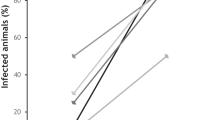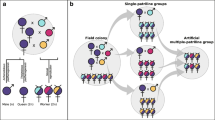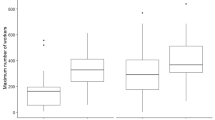Abstract
Social insects are a widespread and ecologically dominant group. Reproductive division of labour among the females in the colonies is a key trait for their success, but at the same time, it creates dense aggregations of relatives which may promote the spread of disease in the colonies. Hence, the appropriate regulation of immune defence is crucial for the well-being of a colony. Inbreeding may disturb this process through reduced resistance or by impairing the colony’s ability to regulate the responses. We tested the effect of inbreeding and the within-colony differences in the encapsulation response between the two female castes of the ant Formica exsecta. New reproductive females (gynes) born in more inbred colonies, and being more inbred themselves, showed an elevated immune response whereas inbreeding had no effect on worker response. Furthermore, the immune response exhibited by gynes was lower than that of workers and was not dependent on their body size whereas the worker response increased with body size. The elevated response is likely to reflect genetic stress caused by inbreeding, which in turn may compromise colony founding and longevity. Indeed, eliciting a high immune response in itself might not be adaptive. Our results show that the regulation of the expression of immunity differs between female castes despite their similar genetic make-up.


Similar content being viewed by others
References
Ahtiainen JJ, Alatalo RV, Kortet R, Rantala MJ (2004) Sexual advertisement and immune function in an arachnid species (Lycosidae). Behav Ecol 15:602–606
Ahtiainen JJ, Alatalo RV, Kortet R, Rantala MJ (2005) A trade-off between sexual signalling and immune function in a natural population of the drumming wolf spider Hygrolycosa rubrofasciata. J Evol Biol 18:985–991
Alexander RD (1974) The evolution of social behavior. Ann Rev Ecolog Syst 5:325–383
Aparicio JM, Ortego J, Cordero PJ (2006) What should we weigh to estimate heterozygosity, alleles or loci? Mol Ecol 15:4659–4665
Ayroles JF, Hughes KA, Rowe KC, Reedy MM, Rodriguez-Zas SL, Drnevich JM, CáCeres CE, Paige KN (2009) A genomewide assessment of inbreeding depression: gene number, function, and mode of action. Cons Biol 23:920–930
Baer B, Schmid-Hempel P (1999) Experimental variation in polyandry affects parasite loads and fitness in a bumble-bee. Nature 397:151–154
Baer B, Armitage SAO, Boomsma JJ (2006) Sperm storage induces an immunity cost in ants. Nature 441:872–875
Bhatkar A, Whitcomb WH (1970) Artificial diet for rearing various species of ants. Flo Entomol 53:229–232
Bocher A, Tirard C, Doums C (2007) Phenotypic plasticity of immune defence linked with foraging activity in the ant Cataglyphis velox. J Evol Biol 20:2228–2234
Boete C, Paul REL, Koella JC (2002) Reduced efficacy of the immune melanization response in mosquitoes infected by malaria parasites. Parasitology 125:93–98
Bouletreau M (1986) The genetic and coevolutionary interaction between parasitoids and their hosts. In: Waage J, Greathead D (eds) Insect parasitoids. Academic, London, pp 169–200
Brown MJF, Moret Y, Schmid-Hempel P (2003) Activation of host constitutive immune defence by an intestinal trypanosome parasite of bumble bees. Parasitology 126:253–260
Calleri DV, Reid EM, Rosengaus RB, Vargo EL, Traniello JFA (2006a) Inbreeding and disease resistance in a social insect: effects of heterozygosity on immunocompetence in the termite Zootermopsis angusticollis. Proc R Soc B 273:2633–2640
Calleri DV, Rosengaus RB, Traniello JFA (2006b) Trade-offs between immunity and reproduction in the dampwood termite Zootermopsis angusticollis. Insect Soc 53:204–211
Castella G, Christe P, Chapuisat M (2009) Mating triggers dynamic immune regulations in wood ant queens. J Evol Biol 22:564–570
Chapuisat M, Oppliger A, Magliano P, Christe P (2007) Wood ants use resin to protect themselves against pathogens. Proc R Soc B 274:2013–2017
Charlesworth D, Charlesworth B (1987) Inbreeding depression and its evolutionary consequences. Annu Rev Ecol Syst 18:237–268
Charlesworth B, Charlesworth D (1999) The genetic basis of inbreeding depression. Genet Res 74:329–340
Charlesworth D, Willis JH (2009) The genetics of inbreeding depression. Nat Rev Genet 10:783–796
Christe P, Oppliger A, Bancalà F, Castella G, Chapuisat M (2003) Evidence for collective medication in ants. Ecol Lett 6:19–22
Cremer S, Sixt M (2009) Analogies in the evolution of individual and social immunity. Phil Trans R Soc B 364:129–142
Cremer S, Armitage SAO, Schmid-Hempel P (2007) Social immunity. Curr Biol 17:R693–R702
Crnokrak P, Roff DA (1999) Inbreeding depression in the wild. Heredity 83:260–270
Doums C, Schmid-Hempel P (2000) Immunocompetence in workers of a social insect, Bombus terrestris L, in relation to foraging activity and parasitic infection. Can J Zool 78:1060–1066
Fortelius W, Rosengren R, Cherix D, Chautems D (1993) Queen recruitment in a highly polygynous supercolony of Formica lugubris (Hymenoptera, Formicidae). Oikos 67:193–200
Frankham R (1995) Conservation genetics. Annu Rev Genet 29:305–327
Galloway TS, Depledge MH (2001) Immunotoxicity in invertebrates: measurement and ecotoxicological relevance. Ecotoxicology 10:5–23
Gerloff CU, Ottmer BK, Schmid-Hempel P (2003) Effects of inbreeding on immune response and body size in a social insect, Bombus terrestris. Funct Ecol 17:582–589
Gillespie JP, Kanost MR, Trenczek T (1997) Biological mediators of insect immunity. Ann Rev Entomol 42:611–643
Gorman MJ, Cornel AJ, Collins FH, Paskewitz SM (1996) A shared genetic mechanism for melanotic encapsulation of CM-Sephadex beads and a malaria parasite, Plasmodium cynomolgi B, in the mosquito, Anopheles gambiae. Exp Parasitol 84:380–386
Götz P (1986) Encapsulation in arthropods. In: Brehélin M (ed) Immunity in invertebrates: cells, molecules, and defense reactions. Springer, Berlin, pp 153–170
Greeff M, Schmid-Hempel P (2008) Sperm reduces female longevity and increases melanization of the spermatheca in the bumblebee Bombus terrestris L. Insect Soc 55:313–319
Haag-Liautard C, Vitikainen E, Keller L, Sundström L (2009) Fitness and the level of homozygosity in a social insect. J Evol Biol 22:134–142
Hedrick PW, Kalinowski ST (2000) Inbreeding depression in conservation biology. Annu Rev Ecol Syst 31:139–162
Keller LF, Waller DM (2002) Inbreeding effects in wild populations. Trends Ecol Evol 17:230–241
Keller L, Liautard C, Reuter M, Brown WD, Sundström L, Chapuisat M (2001) Sex ratio and Wolbachia infection in the ant Formica exsecta. Heredity 87:227–233
Ketola T, Kotiaho JS (2009) Inbreeding, energy use and condition. J Evol Biol 22:770–781
Konig C, Schmid-Hempel P (1995) Foraging activity and immunocompetence in workers of the bumble bee, Bombus terrestris. L Proc R Soc B 260:225–227
Kristensen TN (2006) Inbreeding by environmental interactions affect gene expression in Drosophila melanogaster. Genetics 173:1329–1336
Kristensen TN, Sorensen P, Kruhoffer M, Pedersen KS, Loeschcke V (2005) Genome-wide analysis on inbreeding effects on gene expression in Drosophila melanogaster. Genetics 171:157–167
Lawniczak MK, Barnes AI, Linklater JR, Boone JM, Wigby S, Chapman T (2007) Mating and immunity in invertebrates. Trends Ecol Evol 22:48–55
Liersch S, Schmid-Hempel P (1998) Genetic variation within social insect colonies reduces parasite load. Proc R Soc B 265:221–225
Luong LT, Heath BD, Polak M (2007) Host inbreeding increases susceptibility to ectoparasitism. J Evol Biol 20:79–86
Lynch M, Walsh B (1998) Genetics and analysis of quantitative traits. Sinauer Associates, Sunderland
Ma WH, Chen LZ, Wang M, Li XC (2008) Trade-offs between melanisation and life-history traits in Helicoverpa armigera. Ecol Entomol 33:37–44
Medina LM, Hart AG, Ratnieks FLW (2009) Hygienic behavior in the stingless bees Melipona beecheii and Scaptotrigona pectoralis (Hymenoptera: Meliponini). Genet Mol Res 8:571–576
Moret Y, Schmid-Hempel P (2009) Immune responses of bumblebee workers as a function of individual and colony age: senescence versus plastic adjustment of the immune function. Oikos 118:371–378
Muller C, Schmid-Hempel P (1992) Correlates of reproductive success among field colonies of Bombus lucorum—the importance of growth and parasites. Ecol Entomol 17:343–353
Nappi AJ, Vass E (1993) Melanogenesis and the generation of cytotoxic molecules during insect cellular immune reactions. Pigment Cell Res 6:117–126
O'Brien SJ, Evermann J (1988) Interactive influence of infectious disease and genetic diversity in natural populations. Trends Ecol Evol 3:254–259
Ortius-Lechner D, Maile R, Morgan ED, Boomsma JJ (2000) Metaplural gland secretion of the leaf-cutter ant Acromyrmex octospinosus: new compounds and their functional significance. J Chem Ecol 26:1667–1683
Oster GF, Wilson EO (1978) Caste and ecology in the social insects. Princeton University Press, New Jersey
Paskewitz SM, Riehle M (1994) Response of Plasmodium refractory and susceptible strains of Anopheles gambiae to inoculated Sephadex beads. Dev Comp Immunol 18:369–375
Penn DJ, Potts WK (1999) The evolution of mating preferences and major histocompatibility complex genes. Am Nat 153:145–164
Potts WK, Manning CJ, Wakeland EK, Hughes AL (1994) The role of infectious disease, inbreeding and mating preferences in maintaining MHC genetic diversity: an experimental test [and discussion]. Phil Trans R Soc B 346:369–378
Poulsen M, Bot ANM, Nielsen MG, Boomsma JJ (2002) Experimental evidence for the costs and hygienic significance of the antibiotic metapleural gland secretion in leaf-cutting ants. Behav Ecol Sociobiol 52:151–157
Rantala MJ, Kortet R (2003) Courtship song and immune function in the field cricket Gryllus bimaculatus. Biol J Linn Soc 79:503–510
Rantala MJ, Roff DA (2005) An analysis of trade-offs in immune function, body size and development time in the Mediterranean field cricket, Gryllus bimaculatus. Funct Ecol 19:323–330
Rantala MJ, Roff DA (2006) Analysis of the importance of genotypic variation, metabolic rate, morphology, sex and development time on immune function in the cricket, Gryllus firmus. J Evol Biol 19:834–843
Rantala MJ, Roff DA (2007) Inbreeding and extreme outbreeding cause sex differences in immune defence and life history traits in Epirrita autumnata. Heredity 98:329–336
Rantala MJ, Koskimäki J, Suhonen J, Taskinen J, Tynkkynen K (2000) Immunocompetence, developmental stability and wing spot size in Calopteryx splendens. Proc Royal Soc B 267:2453–2457
Rantala MJ, Jokinen I, Kortet R, Vainikka A, Suhonen J (2002) Do pheromones reveal immunocompetence? Proc Royal Soc B 269:1681–1685
Ratcliffe N, Rowley A, Fitzgerald S, Rhodes C (1985) Invertebrate immunity: basic concepts and recent advances. Int Rev Cytol 97:183–350
Reed DH, Nicholas AC, Stratton GE (2007) Genetic quality of individuals impacts population dynamics. Anim Conserv 10:275–283
Rosengaus RB, Traniello JFA (1993) Disease risk as a cost of outbreeding in the termite Zootermopsis angusticollis. Proc Natl Acad Sci 90:6641–6645
Rosengren R, Pamilo P (1983) The evolution of polygyny and polydomy in mound-building Formica ants. Acta entomol Fenn 42:65–77
Schmid-Hempel P (1998) Parasites in social insects. Princeton University Press, Princeton
Schmid-Hempel P, Crozier RH (1999) Polyandry versus polygyny versus parasites. Phil Trans R Soc B 354:507–515
Schwarzenbach GA, Ward PI (2006) Responses to selection on phenoloxidase activity in yellow dung flies. Evolution 60:1612–1621
Sheldon BC, Verhulst S (1996) Ecological immunology: costly parasite defences and trade-offs in evolutionary ecology. Trends Ecol Evol 11:317–321
Sherman PW, Seeley TD, Reeve HK (1988) Parasites, pathogens, and polyandry in social Hymenoptera. Am Nat 131:602–610
Siva-Jothy MT, Tsubaki Y, Hooper RE (1998) Decreased immune response as a proximate cost of copulation and oviposition in a damselfly. Physiol Entomol 23:274–277
Sorvari J, Rantala LM, Rantala MJ, Hakkarainen H, Eeva T (2007) Heavy metal pollution disturbs immune response in wild ant populations. Environ Pollut 145:324–328
Sorvari J, Hakkarainen H, Rantala MJ (2008) Immune defense of ants is associated with changes in habitat characteristics. Environ Entomol 37:51–56
Spielman D, Brook BW, Briscoe DA, Frankham R (2004) Does inbreeding and loss of genetic diversity decrease disease resistance? Conserv Genet 5:439–448
Stevens L, Yan G, Pray LA (1997) Consequences of inbreeding on invertebrate host susceptibility to parasitic infection. Evolution 51:2032–2039
Sundström L, Chapuisat M, Keller L (1996) Conditional manipulation of sex ratios by ant workers: a test of kin selection theory. Science 274:993–995
Sundström L, Keller L, Chapuisat M (2003) Inbreeding and sex-biased gene flow in the ant Formica exsecta. Evolution 57:1552–1561
Tarlow E, Blumstein DT (2007) Evaluating methods to quantify anthropogenic stressors on animals. Appl Anim Behav Sci 102:429–451
Tarpy DR (2003) Genetic diversity within honeybee colonies prevents severe infections and promotes colony growth. Proc R Soc B 270:99–103
Tian H, Vinson SB, Coates CJ (2004) Differential gene expression between alate and dealate queens in the red imported fire ant, Solenopsis invicta Buren (Hymenoptera: Formicidae). Insect Biochem Mol Biol 34:937–949
Ugelvig LV, Cremer S (2007) Social prophylaxis: group interaction promotes collective immunity in ant colonies. Curr Biol 17:1967–1971
Uvell H, Engström Y (2007) A multilayered defense against infection: combinatorial control of insect immune genes. Trends Genet 23:342–349
Vainio L, Hakkarainen H, Rantala MJ, Sorvari J (2004) Individual variation in immune function in the ant Formica exsecta; effects of the nest, body size and sex. Evol Ecol 18:75–84
Wright S (1977) Evolution and the genetics of populations. Vol. 3. Experimental results and evolutionary deductions, vol 3. University of Chicago Press, Chicago
Zar JH (1999) Biostatistical Analysis. Prentice-Hall, Upper Saddle River
Acknowledgements
We thank Ulla Vattulainen and Hannele Luhtasela-El-Showk for help in the field, and Michel Chapuisat, Heikki Helanterä, Hannele Luhtasela-El Showk, Markus J. Rantala, James Traniello and an anonymous reviewer for helpful comments that greatly improved this manuscript. This study was funded by the Academy of Finland, grant numbers 54952, 206505 and 121216 and the Finnish Society for Sciences and Letters.
Author information
Authors and Affiliations
Corresponding author
Additional information
Communicated by J. Traniello
Rights and permissions
About this article
Cite this article
Vitikainen, E., Sundström, L. Inbreeding and caste-specific variation in immune defence in the ant Formica exsecta . Behav Ecol Sociobiol 65, 899–907 (2011). https://doi.org/10.1007/s00265-010-1090-1
Received:
Revised:
Accepted:
Published:
Issue Date:
DOI: https://doi.org/10.1007/s00265-010-1090-1




